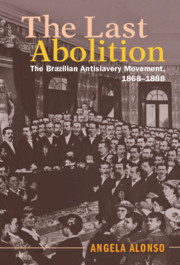Book contents
- The Last Abolition
- Afro-Latin America
- The Last Abolition
- Copyright page
- Dedication
- Contents
- Figures
- Maps
- Tables
- Acknowledgments
- Abbreviations
- Introduction
- 1 Elite Abolitionism
- 2 Pro-Slavery Rhetoric
- 3 The Moral Repertoire of Abolitionism
- 4 The Theatricalization of Politics
- 5 Expansion
- 6 Results-Based Abolitionism
- 7 Votes: A Movement/Government Alliance
- 8 Bullets: Movement and Countermovement
- 9 The March to Victory
- 10 Future of the Preterite
- 11 Abolitionism as a Social Movement
- Annex
- Bibliography
- Index
4 - The Theatricalization of Politics
Published online by Cambridge University Press: 24 September 2021
- The Last Abolition
- Afro-Latin America
- The Last Abolition
- Copyright page
- Dedication
- Contents
- Figures
- Maps
- Tables
- Acknowledgments
- Abbreviations
- Introduction
- 1 Elite Abolitionism
- 2 Pro-Slavery Rhetoric
- 3 The Moral Repertoire of Abolitionism
- 4 The Theatricalization of Politics
- 5 Expansion
- 6 Results-Based Abolitionism
- 7 Votes: A Movement/Government Alliance
- 8 Bullets: Movement and Countermovement
- 9 The March to Victory
- 10 Future of the Preterite
- 11 Abolitionism as a Social Movement
- Annex
- Bibliography
- Index
Summary
The nationalization of abolitionism came about when slavery returned to the institutional agenda in 1878, thanks to the full implementation of the free-womb law and the change of government. After a decade of demanding reforms in the public space, the Liberals were in power. The abolitionists seized the opportunity to step up their protest. A new generation, in part benefiting from the educational reforms of the 1870s, joined the mobilization. Among them was the black journalist José do Patrocínio, who joined Rebouças in founding an abolitionist association and started the “concert-conferences”, an expansion of Abílio Borges´s civic conferences. Held in theaters, with poetry rrecitations and operas, these events ended with the presentation of manumission certificates and a shower of flowers over the freed slaves.This was the preferred abolitionist strategy in the following years, a pacific style of mobilization, which conferred public legitimacy upon the campaign in the large cities and allowed women to enter the campaign. Numeric growth, geographic expansion, tactical variety, and the social diversity of the activists allowed the movement to become national.
Keywords
- Type
- Chapter
- Information
- The Last AbolitionThe Brazilian Antislavery Movement, 1868–1888, pp. 109 - 144Publisher: Cambridge University PressPrint publication year: 2021



